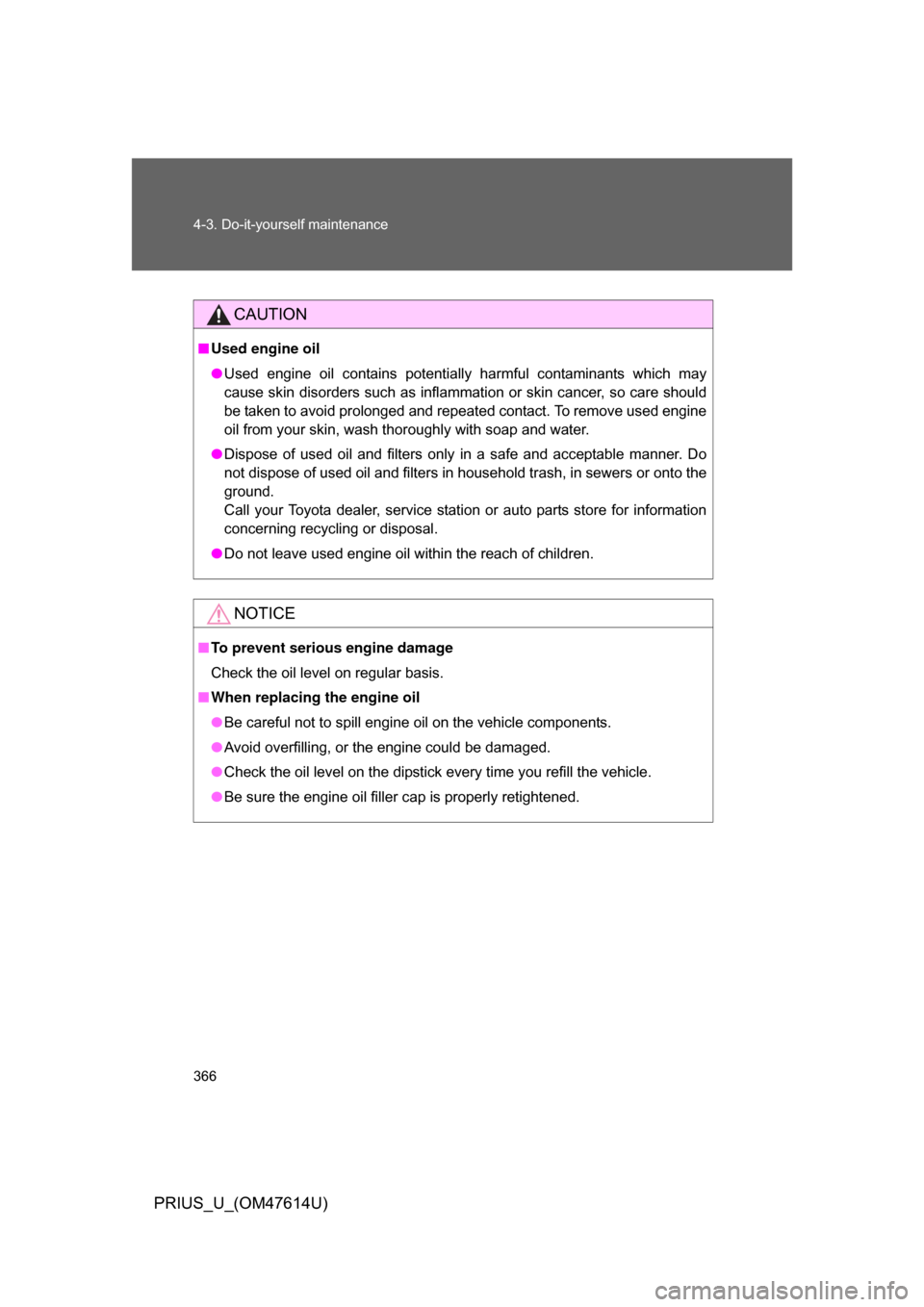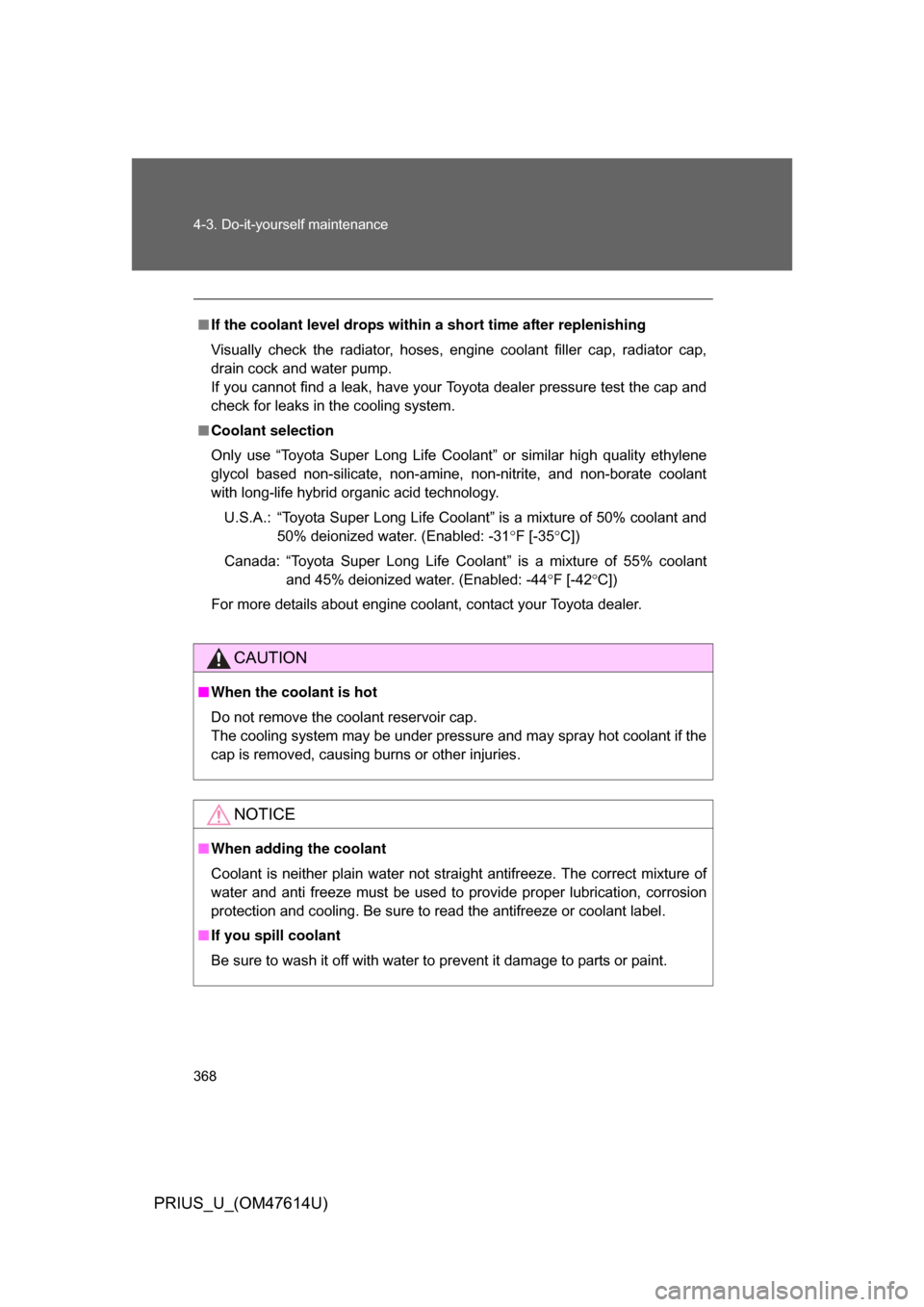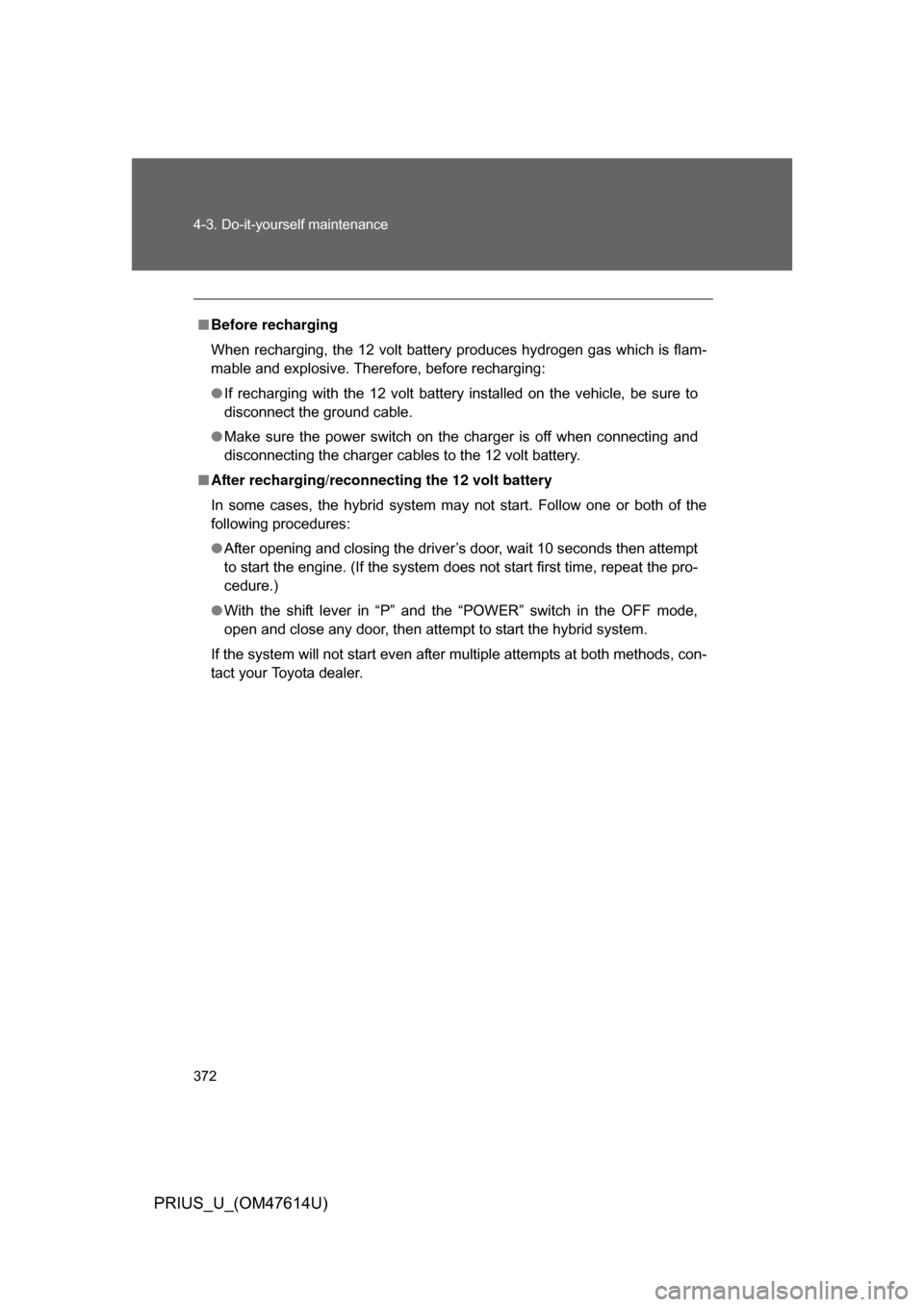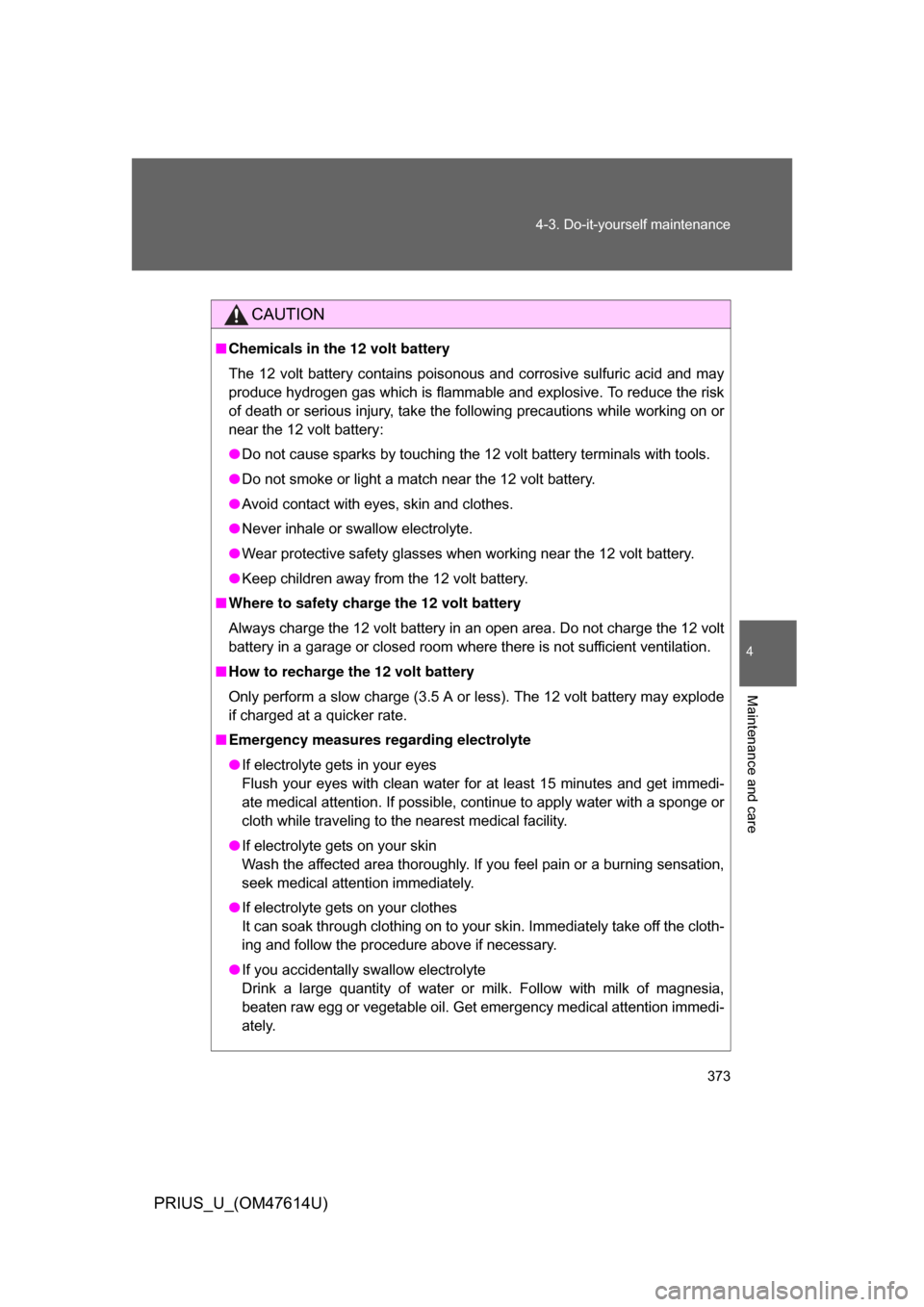Page 366 of 508

366 4-3. Do-it-yourself maintenance
PRIUS_U_(OM47614U)
CAUTION
■Used engine oil
● Used engine oil contains potentially harmful contaminants which may
cause skin disorders such as inflammation or skin cancer, so care should
be taken to avoid prolonged and repeated contact. To remove used engine
oil from your skin, wash thoroughly with soap and water.
● Dispose of used oil and filters only in a safe and acceptable manner. Do
not dispose of used oil and filters in household trash, in sewers or onto the
ground.
Call your Toyota dealer, service station or auto parts store for information
concerning recycling or disposal.
● Do not leave used engine oil within the reach of children.
NOTICE
■To prevent serious engine damage
Check the oil level on regular basis.
■ When replacing the engine oil
● Be careful not to spill engine oil on the vehicle components.
● Avoid overfilling, or the engine could be damaged.
● Check the oil level on the dipstick every time you refill the vehicle.
● Be sure the engine oil filler cap is properly retightened.
Page 367 of 508
367
4-3. Do-it-yourself maintenance
4
Maintenance and care
PRIUS_U_(OM47614U)
Engine/inverter coolant
The coolant level is satisfactory if it is between the “FULL” and “LOW”
lines on the reservoir when the engine is cold.
Engine coolant reservoir Reservoir cap
FULL
LOW
If the level is on or below the
“LOW” line, add coolant up to the
“FULL” line.
Inverter coolant reservoirReservoir cap
FULL
LOW
If the level is on or below the
“LOW” line, add coolant up to the
“FULL” line.
FULL
FULLLOW
LOW
1
2
3
ITY43P012
LOW
FULL
LOW
1
2
3
ITY43P013
Page 368 of 508

368 4-3. Do-it-yourself maintenance
PRIUS_U_(OM47614U)
■If the coolant level drops within a short time after replenishing
Visually check the radiator, hoses, engine coolant filler cap, radiator cap,
drain cock and water pump.
If you cannot find a leak, have your Toyota dealer pressure test the cap and
check for leaks in the cooling system.
■ Coolant selection
Only use “Toyota Super Long Life Coolant” or similar high quality ethylene
glycol based non-silicate, non-amine, non-nitrite, and non-borate coolant
with long-life hybrid organic acid technology.
U.S.A.: “Toyota Super Long Life Coolant” is a mixture of 50% coolant and 50% deionized water. (Enabled: -31 F [-35 C])
Canada: “Toyota Super Long Life Coolant” is a mixture of 55% coolant and 45% deionized water. (Enabled: -44 F [-42C])
For more details about engine coolant, contact your Toyota dealer.
CAUTION
■ When the coolant is hot
Do not remove the coolant reservoir cap.
The cooling system may be under pressure and may spray hot coolant if the
cap is removed, causing burns or other injuries.
NOTICE
■When adding the coolant
Coolant is neither plain water not straight antifreeze. The correct mixture of
water and anti freeze must be used to provide proper lubrication, corrosion
protection and cooling. Be sure to read the antifreeze or coolant label.
■ If you spill coolant
Be sure to wash it off with water to prevent it damage to parts or paint.
Page 369 of 508
369
4-3. Do-it-yourself maintenance
4
Maintenance and care
PRIUS_U_(OM47614U)
Radiator and condenser
Check the radiator and condenser and clear any foreign objects.
If either of the above parts are extremely dirty or you are not sure of
their condition, have your vehicl e checked by your Toyota dealer.
Brake fluid
■ Checking fluid level
The brake fluid level should be
between the “MAX” and “MIN”
lines on the tank.
Make sure to check the fluid type and prepare the necessary items.
■ Adding fluid
CAUTION
■When the engine is hot
Do not touch the radiator or condenser, as they may be hot and you may be
burned.
Fluid typeFMVSS No.116 DOT 3 or SAE J1703 brake fluid
ItemsClean funnel
Page 370 of 508
370 4-3. Do-it-yourself maintenance
PRIUS_U_(OM47614U)
■Brake fluid can absorb moisture from the air
Excess moisture in the fluid can cause a dangerous loss of braking effi-
ciency. Use only newly opened brake fluid.
CAUTION
■When filling the reservoir
Take care because brake fluid can harm your hands or eyes and damage
painted surfaces.
If fluid gets in your eyes, flush your eyes with clean water immediately.
If you still experience discomfort, see a doctor.
NOTICE
■If the fluid level is low
It is normal for the brake fluid level to go down slightly as the brake pads
wear or when the fluid level in the accumulator is high.
If the reservoir needs frequent refilling, it may indicate a serious problem.
Page 371 of 508
371
4-3. Do-it-yourself maintenance
4
Maintenance and care
PRIUS_U_(OM47614U)
12 volt battery
■ Location
The 12 volt battery is located in
the right-hand side of luggage
compartment.
■ 12 volt battery exterior
Make sure that the 12 volt battery terminals are not corroded and that
there are no loose connections, cracks, or loose clamps.
Te r m i n a l s
Hold-down clamp
Page 372 of 508

372 4-3. Do-it-yourself maintenance
PRIUS_U_(OM47614U)
■Before recharging
When recharging, the 12 volt battery produces hydrogen gas which is flam-
mable and explosive. Therefore, before recharging:
● If recharging with the 12 volt battery installed on the vehicle, be sure to
disconnect the ground cable.
● Make sure the power switch on the charger is off when connecting and
disconnecting the charger cables to the 12 volt battery.
■ After recharging/reconnecting the 12 volt battery
In some cases, the hybrid system may not start. Follow one or both of the
following procedures:
● After opening and closing the driver’s door, wait 10 seconds then attempt
to start the engine. (If the system does not start first time, repeat the pro-
cedure.)
● With the shift lever in “P” and the “POWER” switch in the OFF mode,
open and close any door, then attempt to start the hybrid system.
If the system will not start even after multiple attempts at both methods, con-
tact your Toyota dealer.
Page 373 of 508

373
4-3. Do-it-yourself maintenance
4
Maintenance and care
PRIUS_U_(OM47614U)
CAUTION
■
Chemicals in the 12 volt battery
The 12 volt battery contains poisonous and corrosive sulfuric acid and may
produce hydrogen gas which is flammable and explosive. To reduce the risk
of death or serious injury, take the following precautions while working on or
near the 12 volt battery:
● Do not cause sparks by touching the 12 volt battery terminals with tools.
● Do not smoke or light a match near the 12 volt battery.
● Avoid contact with eyes, skin and clothes.
● Never inhale or swallow electrolyte.
● Wear protective safety glasses when working near the 12 volt battery.
● Keep children away from the 12 volt battery.
■ Where to safety charge the 12 volt battery
Always charge the 12 volt battery in an open area. Do not charge the 12 volt
battery in a garage or closed room where there is not sufficient ventilation.
■ How to recharge the 12 volt battery
Only perform a slow charge (3.5 A or less). The 12 volt battery may explode
if charged at a quicker rate.
■ Emergency measures regarding electrolyte
● If electrolyte gets in your eyes
Flush your eyes with clean water for at least 15 minutes and get immedi-
ate medical attention. If possible, continue to apply water with a sponge or
cloth while traveling to the nearest medical facility.
● If electrolyte gets on your skin
Wash the affected area thoroughly. If you feel pain or a burning sensation,
seek medical attention immediately.
● If electrolyte gets on your clothes
It can soak through clothing on to your skin. Immediately take off the cloth-
ing and follow the procedure above if necessary.
● If you accidentally swallow electrolyte
Drink a large quantity of water or milk. Follow with milk of magnesia,
beaten raw egg or vegetable oil. Get emergency medical attention immedi-
ately.